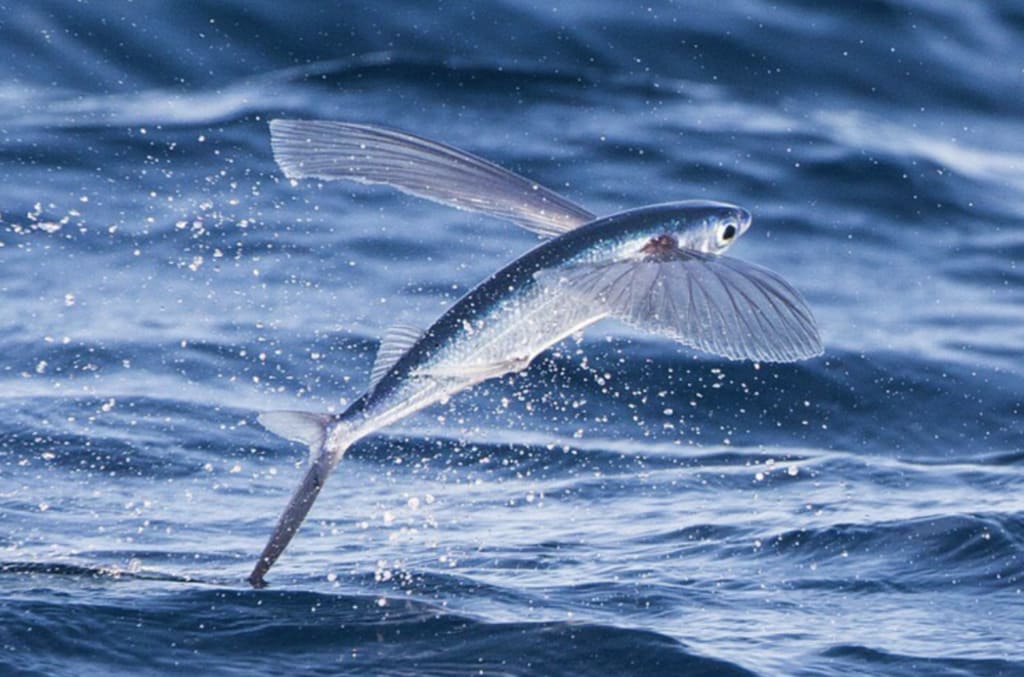Have You All Heard About It?! Flying Fish:
Do You Know It's an Animal Or Bird?: All About Flying Fish:

Flying fish is a type of oceanic fish that has evolved the capacity to glide for great distances above the water's surface. There are around 60 species of flying fish, all of which are members of the Exocoetidae family. They can be found in tropical and subtropical waters throughout the world, but especially in the Atlantic, Pacific, and Indian Oceans.
Flying fish utilize their large, wing-like pectoral fins to raise themselves out of the water and glide through the air. They can glide for up to 200 meters (656 feet) and reach heights of up to 6 meters (20 feet) above the surface of the water. Flying fish use their gliding abilities to avoid predators like dolphins, tuna, and other larger fish.
Flying fish are a vital component of marine ecology, and they are preyed on by a range of creatures, including birds, sharks, and larger fish. Fishermen also catch them for food and to use as bait. Some flying fish species are regarded as delicacies in some cultures, particularly in Japan and other regions of East Asia.
Flying fish are intriguing creatures that have evolved a wonderful adaption that allows them to avoid danger and easily navigate the broad ocean.
Some Further Information On Flying Fish:
- Flying fish have a streamlined body structure and can swim at great speeds underwater. They had a top speed of 60 kilometers per hour (37 miles per hour).
- Flying fish have enormous pectoral fins that can account for up to 30% of their body size. These inflexible fins function as wings, allowing the fish to fly through the air for vast distances.
- Flying fish take off by swimming swiftly near the surface of the water and then propelling themselves into the air with their powerful tail. Once airborne, they can control and direct their flight by adjusting their wings.
- Some flying fish have larger wings and are more suited for long-distance gliding, while others have shorter wings and are better at maneuvering in the air.
- Flying fish are capable of glide rather than continuous flight. Their flights are frequently brief, and they finally return to the sea.
- Flying fish are a vital food source for many marine species, and they are frequently taken for food and as bait by humans.
- Some cultures, such as the ancient Greeks, believed that flying fish was a gift from the god Apollo and incorporated them into their mythology and folklore.
- Despite their capacity to float through the air, flying fish are vulnerable to pollution and habitat damage. Overfishing and climate change are also risks to their populations.
Interesting Facts About Flying Fish:
- Flying fish can glide over such long distances because they have a particular organ known as a "glider bladder" that helps them to stay airborne for longer periods. This bladder is filled with gas and is found in the fish's body cavity.
- Flying fish can vary their speed, altitude, and direction by changing the form and angle of their wings while in flight. This enables them to avoid predators while also conserving energy during long trips.
- Flying fish are good swimmers in addition to their ability to glide. They have a strong tail fin that pushes them through the water, and they can swim at fast speeds to avoid danger.
- Flying fish are a hardy species because they can reproduce quickly and in big numbers. They can lay thousands of eggs at a time, and their eggs hatch in a few days.
- Some flying fish species are bioluminescent, which means they can generate light. They use this ability to attract mates as well as to confuse predators with flashes of light.
- Flying fish meat is high in protein and considered a delicacy in many parts of the world. Flying fish roe (eggs), for example, is a popular element in sushi in Japan.
- Flying fish have been seen flying in groups, which may give some protection from predators. The fish can mislead and overwhelm their assailants by flying in groups.
- Overall, flying fish are fascinating organisms with a variety of unusual adaptations that enable them to survive in their maritime habitat. Their ability to glide through the air is especially stunning, and it has captured the curiosity of people all across the world.
#naturelove #creations #species #science # information
About the Creator
PearlyJasmine
I really enjoy writing and I want to explore this universe more. I always dream about fantasy and creating stories in my world.






Comments (1)
"glider bladder" isn't a real thing, I do believe you've gotten it confused with gas bladder, an organ used to regulate buoyancy underwater